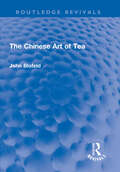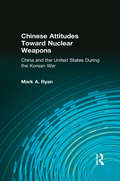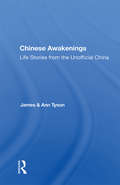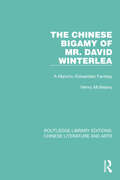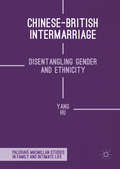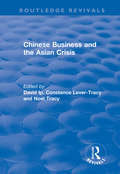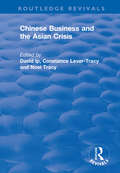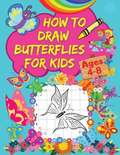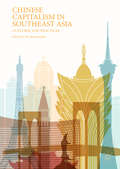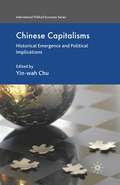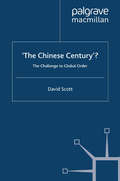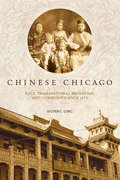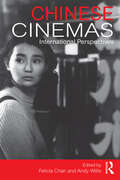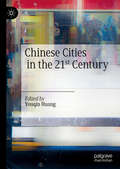- Table View
- List View
The Chinese Art of Tea (Routledge Revivals)
by John BlofeldFirst published in 1985, The Chinese Art of Tea is an exploration into the history of tea and the Chinese art of tea, known as ch’a-shu. The book begins by delving into the history and legends surrounding tea before moving on to a study of the Emperor Hui Tsung’s treatise on tea and approaches to tea during the Ming Dynasty. It discusses tea gardens, teahouses, the relationship between tea and ceramics, and the connection between tea and health. The book also features a detailed manual for practising the art of drinking tea, including advice for choosing tea, buying tea, different types of infusion and drinking vessels, and the attitude required for obtaining the fullest satisfaction from tea. The Chinese Art of Tea is ideal for anyone with an interest in the history and art of drinking tea, and the social and cultural history of China.
The Chinese Art of Tea (Routledge Revivals)
by John BlofeldFirst published in 1985, The Chinese Art of Tea is an exploration into the history of tea and the Chinese art of tea, known as ch’a-shu. The book begins by delving into the history and legends surrounding tea before moving on to a study of the Emperor Hui Tsung’s treatise on tea and approaches to tea during the Ming Dynasty. It discusses tea gardens, teahouses, the relationship between tea and ceramics, and the connection between tea and health. The book also features a detailed manual for practising the art of drinking tea, including advice for choosing tea, buying tea, different types of infusion and drinking vessels, and the attitude required for obtaining the fullest satisfaction from tea. The Chinese Art of Tea is ideal for anyone with an interest in the history and art of drinking tea, and the social and cultural history of China.
Chinese Attitudes Toward Nuclear Weapons: China and the United States During the Korean War
by Mark A. RyanThis book examines the crucial formative period of Chinese attitudes toward nuclear weapons - the immediate post-Hiroshima/Nagasaki period and the Korean War. It provides a detailed account of U.S. actions and attitudes during this period and China's response, which was especially acute after both countries had entered the Korean conflict as enemies. This response dispels some of the myths that have long existed regarding China's perceptions of nuclear war.
Chinese Attitudes Toward Nuclear Weapons: China and the United States During the Korean War
by Mark A. RyanThis book examines the crucial formative period of Chinese attitudes toward nuclear weapons - the immediate post-Hiroshima/Nagasaki period and the Korean War. It provides a detailed account of U.S. actions and attitudes during this period and China's response, which was especially acute after both countries had entered the Korean conflict as enemies. This response dispels some of the myths that have long existed regarding China's perceptions of nuclear war.
Chinese Awakenings: Life Stories From The Unofficial China
by James Tyson Ann TysonThis evocative and fascinating book shows how, from muddy village crossroads to raucous city streets, Chinese exhilarated by new dreams are shaping the future of their nation. Over the course of five years spent as China correspondents for the Christian Science Monitor, James and Ann Tyson dodged government surveillance and sought out the life stories of Chinese throughout the country: in the yak-hair tents of Tibetan nomads, the cramped Shanghai garret of China's most courageous dissident, the seaside mansion of a multimillionaire, and the tiny sheet-metal workshop of a peasant migrant. Allowing the Chinese to speak for themselves, the Tysons have written a book unique among Western studies of China for painting in vivid detail a firsthand portrait of a broad spectrum of Chinese. Through these diverse voices, the Tysons reveal how, with economic reform weakening the grip of the state over everyday life, the people of China are taking the future into their own hands. The initiative for change is coming increasingly from below, as millions of Chinese pursuing their own dreams propel reform far beyond the Communist Party's original intent. Chinese Awakenings provides an intimate understanding of the feelings, aspirations, and workaday lives of ordinary Chinese. It offers the crucial insight into grassroots society that is essential for discerning what lies ahead for China's 1.2 billion people.
Chinese Awakenings: Life Stories From The Unofficial China
by James Tyson Ann TysonThis evocative and fascinating book shows how, from muddy village crossroads to raucous city streets, Chinese exhilarated by new dreams are shaping the future of their nation. Over the course of five years spent as China correspondents for the Christian Science Monitor, James and Ann Tyson dodged government surveillance and sought out the life stories of Chinese throughout the country: in the yak-hair tents of Tibetan nomads, the cramped Shanghai garret of China's most courageous dissident, the seaside mansion of a multimillionaire, and the tiny sheet-metal workshop of a peasant migrant. Allowing the Chinese to speak for themselves, the Tysons have written a book unique among Western studies of China for painting in vivid detail a firsthand portrait of a broad spectrum of Chinese. Through these diverse voices, the Tysons reveal how, with economic reform weakening the grip of the state over everyday life, the people of China are taking the future into their own hands. The initiative for change is coming increasingly from below, as millions of Chinese pursuing their own dreams propel reform far beyond the Communist Party's original intent. Chinese Awakenings provides an intimate understanding of the feelings, aspirations, and workaday lives of ordinary Chinese. It offers the crucial insight into grassroots society that is essential for discerning what lies ahead for China's 1.2 billion people.
The Chinese Bigamy of Mr. David Winterlea: A Manchu-Edwardian Fantasy (Routledge Library Editions: Chinese Literature and Arts #4)
by Henry McAleavyThis book, first published in 1961, is a translation of an anonymously-written Chinese work first written in 1913 and published in Shanghai in serial form with illustrations. It is an excellent example of the popular Chinese literature featuring romances between foreigners and the Chinese, and relates the story of Mr Feng, successful merchant, and David Winterlea, English diplomat, and the sisters Lotus and Peony.
The Chinese Bigamy of Mr. David Winterlea: A Manchu-Edwardian Fantasy (Routledge Library Editions: Chinese Literature and Arts #4)
by Henry McAleavyThis book, first published in 1961, is a translation of an anonymously-written Chinese work first written in 1913 and published in Shanghai in serial form with illustrations. It is an excellent example of the popular Chinese literature featuring romances between foreigners and the Chinese, and relates the story of Mr Feng, successful merchant, and David Winterlea, English diplomat, and the sisters Lotus and Peony.
Chinese-British Intermarriage: Disentangling Gender and Ethnicity (Palgrave Macmillan Studies in Family and Intimate Life)
by Yang HuExploring how people negotiate and reconcile, construct and re-construct their distinctive gender and ethnic identities in a cross-cultural context, Hu examines what happens when two distinct cultures meet at the intimate interface of marriage and family. Chinese-British Intermarriage reveals how gender and ethnic identities intersect in distinctive ways in shaping the lived experiences of intermarried couples. Through the kaleidoscope of first-generation Chinese-British inter-ethnic families in the UK, the book brings together family, gender, migration and ethnic studies, reflecting on ongoing social processes such as individualisation and globalisation.
Chinese Business and the Asian Crisis
by David Fu-Keung Ip Constance Lever-Tracy Noel TracyThis title was first published in 2000: The Asian financial crisis and its aftermath provide a crucible in which Chinese diaspora capitalism has been tested, and a prism through which its strengths and weaknesses may be seen in a different light. The papers collected in this volume are in many ways still tentative. Some represent work-in-progress reports on as yet uncompleted research. In other cases, outcomes explored are still unclear or have not even yet fully unfolded. The aim is to focus on the consquences for diaspora Chinese capitalists and to start trying to identify losers and winners in the new landscape, re-evaluating their business culture, strategies and modes of operation, and their likely future direction and potential. The book begins by setting the scene for the Asian crisis and the achievements of the "Asian miracle". It then goes on to examine the causes of the financial crash, the firms that were able to ride the crisis, the Taiwanese economy as a whole, the fortunes of diaspora ventures in China, the small and medium enterprises at the heart of Chinese diaspora capitalism, the impact of the crisis on large Chinese business groups, and finally, the book debunks the theory that the rise of East Asia was initiated by Japan.
Chinese Business and the Asian Crisis
by David Fu-Keung Ip Constance Lever-Tracy Noel TracyThis title was first published in 2000: The Asian financial crisis and its aftermath provide a crucible in which Chinese diaspora capitalism has been tested, and a prism through which its strengths and weaknesses may be seen in a different light. The papers collected in this volume are in many ways still tentative. Some represent work-in-progress reports on as yet uncompleted research. In other cases, outcomes explored are still unclear or have not even yet fully unfolded. The aim is to focus on the consquences for diaspora Chinese capitalists and to start trying to identify losers and winners in the new landscape, re-evaluating their business culture, strategies and modes of operation, and their likely future direction and potential. The book begins by setting the scene for the Asian crisis and the achievements of the "Asian miracle". It then goes on to examine the causes of the financial crash, the firms that were able to ride the crisis, the Taiwanese economy as a whole, the fortunes of diaspora ventures in China, the small and medium enterprises at the heart of Chinese diaspora capitalism, the impact of the crisis on large Chinese business groups, and finally, the book debunks the theory that the rise of East Asia was initiated by Japan.
Chinese Business and the Asian Crisis
by David Ip Constance Lever-Tracy Noel TracyThis title was first published in 2000: The Asian financial crisis and its aftermath provide a crucible in which Chinese diaspora capitalism has been tested, and a prism through which its strengths and weaknesses may be seen in a different light. The papers collected in this volume are in many ways still tentative. Some represent work-in-progress reports on as yet uncompleted research. In other cases, outcomes explored are still unclear or have not even yet fully unfolded. The aim is to focus on the consquences for diaspora Chinese capitalists and to start trying to identify losers and winners in the new landscape, re-evaluating their business culture, strategies and modes of operation, and their likely future direction and potential. The book begins by setting the scene for the Asian crisis and the achievements of the "Asian miracle". It then goes on to examine the causes of the financial crash, the firms that were able to ride the crisis, the Taiwanese economy as a whole, the fortunes of diaspora ventures in China, the small and medium enterprises at the heart of Chinese diaspora capitalism, the impact of the crisis on large Chinese business groups, and finally, the book debunks the theory that the rise of East Asia was initiated by Japan.
Chinese Business and the Asian Crisis
by David Ip Constance Lever-Tracy Noel TracyThis title was first published in 2000: The Asian financial crisis and its aftermath provide a crucible in which Chinese diaspora capitalism has been tested, and a prism through which its strengths and weaknesses may be seen in a different light. The papers collected in this volume are in many ways still tentative. Some represent work-in-progress reports on as yet uncompleted research. In other cases, outcomes explored are still unclear or have not even yet fully unfolded. The aim is to focus on the consquences for diaspora Chinese capitalists and to start trying to identify losers and winners in the new landscape, re-evaluating their business culture, strategies and modes of operation, and their likely future direction and potential. The book begins by setting the scene for the Asian crisis and the achievements of the "Asian miracle". It then goes on to examine the causes of the financial crash, the firms that were able to ride the crisis, the Taiwanese economy as a whole, the fortunes of diaspora ventures in China, the small and medium enterprises at the heart of Chinese diaspora capitalism, the impact of the crisis on large Chinese business groups, and finally, the book debunks the theory that the rise of East Asia was initiated by Japan.
Chinese Calligraphy: An Introduction to Its Aesthetic and Technique, Third Revised and Enlarged Edition
by Yee ChiangThis is the classic introduction to Chinese calligraphy. In nine richly illustrated chapters Chang explores the aesthetics and the technique of this art in which rhythm, line, and structure are perfectly embodied. He measure the slow change from pictograph to stroke to the style and shape of written characters by the great calligraphers. It is a superb appreciation of beauty in the movement of strokes and in the patterns of structure--and an inspiration to amateurs as well as professionals interested in the decorative arts.
Chinese Calligraphy: An Introduction to Its Aesthetic and Technique, Third Revised and Enlarged Edition
by Yee ChiangThis is the classic introduction to Chinese calligraphy. In nine richly illustrated chapters Chang explores the aesthetics and the technique of this art in which rhythm, line, and structure are perfectly embodied. He measure the slow change from pictograph to stroke to the style and shape of written characters by the great calligraphers. It is a superb appreciation of beauty in the movement of strokes and in the patterns of structure--and an inspiration to amateurs as well as professionals interested in the decorative arts.
Chinese Capitalism in Southeast Asia: Cultures and Practices
by Yos SantasombatThis collection examines the historically and geographically specific form of economic organization of the overseas Chinese in Southeast Asia and how it has adapted to the different historical and socio-political contexts of Southeast Asian countries. Moving beyond cultural explanations and traits to focus on the process of evolution and dynamism of situated practices, it argues that Chinese Capitalism is rapidly becoming a form of ‘hybrid capitalism’ and embodies the interdependent of culturally and institutionally specific dynamics at local and regional level, evolving and adapting to different institutional contexts and politico-economic conditions in the host Asian economies. This text also explores the social organization and political economy of the so-called overseas Chinese by examining the changing dynamism of Chinese capitalism in relation to forces of globalization. Focusing on key actors, primarily Chinese entrepreneurs in their business practices, and situated practices as well as cultural, political, social and economic factors under globalizing conditions, it provides providing a broad understanding without fixating or homogenizing Chinese capitalism, contributing to the understanding of the contexts that give rise to the emergence and transformation of Chinese Capitalism in Southeast Asia.
Chinese Capitalism in Southeast Asia: Cultures and Practices
by Yos SantasombatThis collection examines the historically and geographically specific form of economic organization of the overseas Chinese in Southeast Asia and how it has adapted to the different historical and socio-political contexts of Southeast Asian countries. Moving beyond cultural explanations and traits to focus on the process of evolution and dynamism of situated practices, it argues that Chinese Capitalism is rapidly becoming a form of ‘hybrid capitalism’ and embodies the interdependent of culturally and institutionally specific dynamics at local and regional level, evolving and adapting to different institutional contexts and politico-economic conditions in the host Asian economies. This text also explores the social organization and political economy of the so-called overseas Chinese by examining the changing dynamism of Chinese capitalism in relation to forces of globalization. Focusing on key actors, primarily Chinese entrepreneurs in their business practices, and situated practices as well as cultural, political, social and economic factors under globalizing conditions, it provides providing a broad understanding without fixating or homogenizing Chinese capitalism, contributing to the understanding of the contexts that give rise to the emergence and transformation of Chinese Capitalism in Southeast Asia.
Chinese Capitalism in Southeast Asia: Cultures and Practices
by Yos SantasombatThis collection examines the historically and geographically specific form of economic organization of the overseas Chinese in Southeast Asia and how it has adapted to the different historical and socio-political contexts of Southeast Asian countries. Moving beyond cultural explanations and traits to focus on the process of evolution and dynamism of situated practices, it argues that Chinese Capitalism is rapidly becoming a form of ‘hybrid capitalism’ and embodies the interdependent of culturally and institutionally specific dynamics at local and regional level, evolving and adapting to different institutional contexts and politico-economic conditions in the host Asian economies. This text also explores the social organization and political economy of the so-called overseas Chinese by examining the changing dynamism of Chinese capitalism in relation to forces of globalization. Focusing on key actors, primarily Chinese entrepreneurs in their business practices, and situated practices as well as cultural, political, social and economic factors under globalizing conditions, it provides providing a broad understanding without fixating or homogenizing Chinese capitalism, contributing to the understanding of the contexts that give rise to the emergence and transformation of Chinese Capitalism in Southeast Asia.
Chinese Capitalisms: Historical Emergence and Political Implications (International Political Economy Series)
by Y. ChuIn Chinese Capitalisms , experts examine the rise of capitalism on China and Taiwan, analyzing impacts exerted by global capitalism, Chinese civilization, and remnants of socialist practice. In focusing on these, they also address longstanding issues such as Weber's China Thesis, state-business relationships, and China's civil society, among others.
'The Chinese Century'?: The Challenge to Global Order (Global Issues)
by D. ScottThis book looks ahead to consider the most likely results of the encounter between China and the international system. Environmental, cultural and perceptual matters are considered as well as more traditional economic and military issues. Underpinning the book is the question will the 21st century be 'China's Century', for China and the world?
Chinese Chicago: Race, Transnational Migration, and Community Since 1870 (Asian America #74)
by Huping LingNumerous studies have documented the transnational experiences and local activities of Chinese immigrants in California and New York in the late nineteenth and early twentieth centuries. Less is known about the vibrant Chinese American community that developed at the same time in Chicago. In this sweeping account, Huping Ling offers the first comprehensive history of Chinese in Chicago, beginning with the arrival of the pioneering Moy brothers in the 1870s and continuing to the present. Ling focuses on how race, transnational migration, and community have defined Chinese in Chicago. Drawing upon archival documents in English and Chinese, she charts how Chinese made a place for themselves among the multiethnic neighborhoods of Chicago, cultivating friendships with local authorities and consciously avoiding racial conflicts. Ling takes readers through the decades, exploring evolving family structures and relationships, the development of community organizations, and the operation of transnational businesses. She pays particular attention to the influential role of Chinese in Chicago's academic and intellectual communities and to the complex and conflicting relationships among today's more dispersed Chinese Americans in Chicago.
Chinese Cinemas: International Perspectives
by Felicia Chan Andy WillisChinese Cinemas: International Perspectives examines the impact the rapid expansion of Chinese filmmaking in mainland China has had on independent and popular Chinese cinemas both in and outside of China. While the large Chinese markets are coveted by Hollywood, the commercial film industry within the People’s Republic of China has undergone rapid expansion since the 1990s. Its own production, distribution and exhibition capacities have increased exponentially in the past 20 years, producing box-office success both domestically and abroad. This volume gathers the work of a range of established scholars and newer voices on Chinese cinemas to address questions that interrogate both Chinese films and the place and space of Chinese cinemas within the contemporary global film industries, including the impact on independent filmmaking both within and outside of China; the place of Chinese cinemas produced outside of China; and the significance of new internal and external distribution and exhibition patterns on recent conceptions of Chinese cinemas. This is an ideal book for students and researchers interested in Chinese and Asian Cinema, as well as for students studying topics such as World Cinema and Asian Studies.
Chinese Cinemas: International Perspectives
by Felicia Chan Andy WillisChinese Cinemas: International Perspectives examines the impact the rapid expansion of Chinese filmmaking in mainland China has had on independent and popular Chinese cinemas both in and outside of China. While the large Chinese markets are coveted by Hollywood, the commercial film industry within the People’s Republic of China has undergone rapid expansion since the 1990s. Its own production, distribution and exhibition capacities have increased exponentially in the past 20 years, producing box-office success both domestically and abroad. This volume gathers the work of a range of established scholars and newer voices on Chinese cinemas to address questions that interrogate both Chinese films and the place and space of Chinese cinemas within the contemporary global film industries, including the impact on independent filmmaking both within and outside of China; the place of Chinese cinemas produced outside of China; and the significance of new internal and external distribution and exhibition patterns on recent conceptions of Chinese cinemas. This is an ideal book for students and researchers interested in Chinese and Asian Cinema, as well as for students studying topics such as World Cinema and Asian Studies.
Chinese Cities in the 21st Century
by Youqin HuangThis book is an interdisciplinary examination of China's new urban development model and the challenges Chinese cities face in the 21st century. China is in the midst of a historic developmental inflection point, grappling with a significantly slowing economy, rapidly rising inequality, massive migration, skyrocketing housing prices, alarming environmental problems, and strong pushback from the West. In this volume, Western and Chinese scholars in different disciplines offer the clearest look yet at some of the main challenges China faces, including domestic and international contexts, the new urban development model, inclusion and well-being of migrants and their families, and urban sustainability. This book sheds light on China’s ongoing development and future directions, and has strong policy implications for anyone interested in the future of China.
